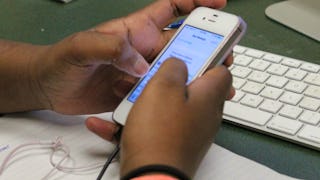This course will guide you through the basic elements of professional journalism and the news values and ethics of covering real-world issues and events. The overview and examples of the types of news coverage helps introduce the different types of journalism, such as social media, multimedia, print, visual and broadcast, and how professional journalists effectively use each format.

Gain next-level skills with Coursera Plus for $199 (regularly $399). Save now.

What is news?
This course is part of Become a Journalist: Report the News! Specialization



Instructors: Joanne C. Gerstner
45,086 already enrolled
Included with
(1,181 reviews)
Skills you'll gain
Details to know

Add to your LinkedIn profile
See how employees at top companies are mastering in-demand skills

Build your subject-matter expertise
- Learn new concepts from industry experts
- Gain a foundational understanding of a subject or tool
- Develop job-relevant skills with hands-on projects
- Earn a shareable career certificate

There are 5 modules in this course
You will learn about the School of Journalism, our award-winning faculty and the world-class atmosphere of Michigan State University. We are a special place, where amazing things happen every day.
What's included
4 videos1 discussion prompt
In every module of this course, we will go deeper into journalistic values and ethics. In many ways, these values are what distinguish journalism from the many other kinds of content. You will learn how to move beyond creating content to creating journalism through understanding and using these values.
What's included
7 videos3 readings7 assignments2 discussion prompts
You will learn how to reach your audience and community as a journalist, by exploring news reports, interest and importance, and values and ethics.
What's included
3 videos1 reading2 assignments1 discussion prompt
Understanding the ways journalism happens is just as important as knowing how to do it. There are many different types of journalism, as our world is filled with so many things to communicate about: sports, cars, celebrities, movies, war, business, real estate, pets, art...if you can name it, you can do journalism about it.
What's included
6 videos1 reading5 assignments3 peer reviews1 discussion prompt
Journalists are working in new and exciting places such as social media. Technology has allowed the profession and journalists to do their jobs in innovative ways. You will learn about how technology impacts journalism, and best practices for blogs, Twitter, Instagram, Periscope, WeChat, Facebook and other realities of engaging in social media.
What's included
5 videos1 reading3 assignments1 peer review
Earn a career certificate
Add this credential to your LinkedIn profile, resume, or CV. Share it on social media and in your performance review.
Instructors


Offered by
Explore more from Music and Art
 Status: Free Trial
Status: Free TrialMichigan State University
 Status: Preview
Status: PreviewThe University of Hong Kong
 Status: Free Trial
Status: Free TrialMichigan State University
 Status: Free Trial
Status: Free TrialMichigan State University
Why people choose Coursera for their career




Learner reviews
1,181 reviews
- 5 stars
79.52%
- 4 stars
15.73%
- 3 stars
3.04%
- 2 stars
0.42%
- 1 star
1.26%
Showing 3 of 1181
Reviewed on Apr 26, 2020
Very good because it is taught about all the basics of journalists. Various case studies also train me to be able to think more with the mindset of a journalist. I highly recommend this class.
Reviewed on Oct 10, 2021
Excellent introductory course. Journalism is not something I have studied before and this was a perfect introductory course. The presenters were engaging and authentic.
Reviewed on Jun 7, 2020
I really enjoyed learning all of the different parts dealing with Journalism. I thought that the videos and the light reading made for a great learning experience. Thanks, Denise Shannon.

Open new doors with Coursera Plus
Unlimited access to 10,000+ world-class courses, hands-on projects, and job-ready certificate programs - all included in your subscription
Advance your career with an online degree
Earn a degree from world-class universities - 100% online
Join over 3,400 global companies that choose Coursera for Business
Upskill your employees to excel in the digital economy
Frequently asked questions
To access the course materials, assignments and to earn a Certificate, you will need to purchase the Certificate experience when you enroll in a course. You can try a Free Trial instead, or apply for Financial Aid. The course may offer 'Full Course, No Certificate' instead. This option lets you see all course materials, submit required assessments, and get a final grade. This also means that you will not be able to purchase a Certificate experience.
When you enroll in the course, you get access to all of the courses in the Specialization, and you earn a certificate when you complete the work. Your electronic Certificate will be added to your Accomplishments page - from there, you can print your Certificate or add it to your LinkedIn profile.
Yes. In select learning programs, you can apply for financial aid or a scholarship if you can’t afford the enrollment fee. If fin aid or scholarship is available for your learning program selection, you’ll find a link to apply on the description page.
More questions
Financial aid available,
¹ Some assignments in this course are AI-graded. For these assignments, your data will be used in accordance with Coursera's Privacy Notice.




